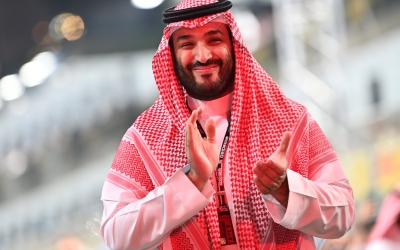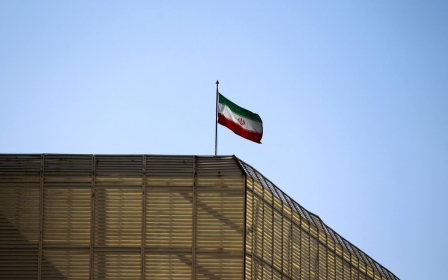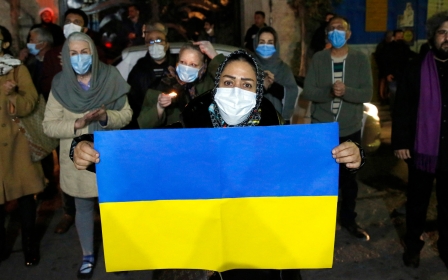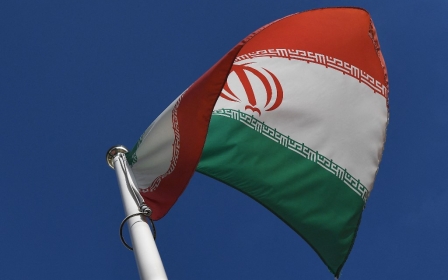The curious case of the Israeli rabbi in Iran

Jacob Yisrael Herzog, an ultra-Orthodox Israeli rabbi, is known for appearing in unusual places.
He describes himself as the “chief rabbi in Saudi Arabia" and a "preacher of interfaith dialogue", and has been seen in the kingdom several times in recent months, despite Israel and Riyadh sharing no overt diplomatic ties.
Last month, however, he made a rather more unorthodox trip for an Israeli - to Iran, Israel's arch-nemesis.
Under Iranian law, Israeli citizens are not allowed to enter the country. But according to a report in the Times of Israel, Herzog was able to enter using his US passport.
According to the newspaper, Herzog, who lives in Jerusalem with his wife and eight children, has previously attempted to establish a Jewish community in Saudi Arabia, travelling to the kingdom five times since last summer.
New MEE newsletter: Jerusalem Dispatch
Sign up to get the latest insights and analysis on Israel-Palestine, alongside Turkey Unpacked and other MEE newsletters
In Tehran, he was seen posting photos of himself at the Grand Bazaar and at a site believed to be the Tomb of Esther and Mordechai, wearing his traditional ultra-Orthodox clothing.
Iran has the largest community of Jews in the Middle East outside Israel, with around 9,000 Jewish Iranians believed to live in the country.
People close to Herzog have said that the visit was supposed to advance issues relating to the local Jewish community.
However, Homayoun Najafabadi, the representative of the Iranian-Jewish community in parliament, said Herzog’s trip had nothing to do with the community's leaders.
"I am opposed to this trip, because no Zionist is allowed to communicate with the Jewish community in Iran under any circumstances, and this [trip] is unacceptable in the view of the Iranian-Jewish community,” he said.
With Iran's hardline leaders constantly preaching staunch anti-Zionist and pro-Palestinian beliefs and policies, the arrival of an Israeli was met with bafflement by much of the public. It also subjected the authorities to accusations of hypocrisy.
'Ordinary tourist'
One of the sights Herzog took in on his trip was Dr Sapir Hospital and Charity Centre, a Jewish hospital in Tehran, where he again took the opportunity to be photographed.
Siamak Morsadegh, the hospital's director, said that he had not met with Herzog.
“I, and the Jewish community of Iran, are in no need to meet him," he said.
'The real question is whether the intelligence organisations followed him, which I believe they did'
- European diplomat
"Fortunately, we have enough Jewish clerics in our country who have been educated on the basis of Iranian monotheistic values, and there is no need for him.”
He added that Herzog was “probably an ordinary tourist who came to Iran”.
Discussing Herzog's visit, a European diplomat who used to serve in his country’s embassy in Tehran, told Middle East Eye: “If this man used, as it seems, an American passport, he should not have had any problem entering Iran.
“As you know, recently various American citizens arrived in Tehran without problems. So if he presented himself as an American citizen, it is no surprise that they did not stop him," he added.
"The real question is whether the intelligence organisations followed him, which I believe they did."
'Iran is being tarnished'
Some media organisations, including Revolutionary Guard-affiliated outlets, along with many Twitter users who are politically close to conservative and pro-government currents in Iran, have slammed the authorities for permitting Herzog's entry.
An editorial in the conservative Kayhan newspaper, whose editor is appointed by Supreme Leader Ayatollah Ali Khamenei, wrote: “Is he a Torah teacher or a Mossad spy?”
“Responsible [authorities] must be held accountable,” the editorial warned.
Moderate newspaper Jomhouri Eslami also took aim, writing that government officials, especially the foreign, interior, and tourism ministries, must answer “how this known Zionist, living in the occupied territories, was able to travel to Iran and visit the places he wanted?”
A conservative journalist, who wished to remain anonymous, told MEE: “I don’t know where the foreign ministry and security officials were? What were they doing at the time?
“I guess the authorities do not realise, or notice, that the image of the Islamic Republic is being tarnished in the Islamic world, and consequently the nation's decades-long cost of resistance in the face of the West is being destroyed?" he asked.
"Why has parliament remained silent and the ministers not held accountable?”
Simultaneously with the conservatives, reformists also criticised hardliners and President Ebrahim Raisi's government for their “hypocrisy”.
Hadi Mousavi, a reformist activist, wrote: “An Israeli rabbi wandered in Tehran for several days, but neither the security organisations, nor the [conservative] media, are worried."
Mousavi also highlighted what he considered the double standards of hardliners, arguing that Nizar Zakka, a Lebanese US resident arrested in 2015 for allegedly spying for Washington, had been detained for no reason other than to undermine the moderate government of former president Hassan Rouhani.
Another scandal
The controversy around Herzog's visit came as attention is also being focused on a Times of Israel blog by Catherine Perez-Shakdam, a French Jewish political analyst, author and commentator on the Middle East, who revealed how she had been able to conduct an interview in Iran in 2017 with the then-presidential candidate Raisi.
Although the blog was written in November, it recently found its way onto Iran’s social networks and media after being highlighted by the Telegram news channel "Third", which is close to the former hardline president Mahmoud Ahmadinejad.
In the blog, Perez-Shakdam described how she had secured the interview despite the fact that "under Iran’s strict rules, no foreign journalist, unless under special request and recommendation, can be allowed to interview a presidential candidate on the eve of the elections".
Perez-Shakdam described how she had been able to visit Tehran by using her French passport, and said that “one of the main propagandists of the [1979] Islamic Revolution, a man educated in the United States” had introduced her to Raisi.
“Formerly married to a Muslim hailing from Yemen, my marriage gave me a free pass to many Islamic countries,” she added.
'Israeli spy'
Perez-Shakdam’s articles and interviews are found on conservative news agencies and even Khamenei's website.
However, most of her pieces have now been removed following the revelations.
In reaction, Khamenei’s website issued a statement on 27 February, announcing that Perez-Shakdam had been introduced to officials at the website through “some media activists interested in the Islamic Revolution”.
The statement said Perez-Shakdam had written articles on “issues related to the values of Islam and the Islamic Revolution” but that she had no relations with the website.
'If this trip had occurred during the presidency of a reformist, or the Jewish woman had written articles for reformist media, the hardliners would have made them miserable'
- Reformist journalist
The Telegram news channel "Third" claimed that in her blog Perez-Shakdam's had revealed how she was an Israeli spy and had infiltrated Iran's power circles.
However, the Republican Guard-affiliated Tasnim news agency, which also published articles by Perez-Shakdam, pointed out that this claim was false and that the journalist had not identified herself as a spy in her blog.
“Some who know her analyse that she is most likely planning to implement her opportunistic economic project, which failed in Iran, in the Zionist regime," said Tasnim, using the Iranian government's preferred term for Israel.
Speaking to MEE on condition of anonymity for fear of repercussions, a reformist journalist said: “The hardliners are such hypocrites that they have sought to ignore these two scandals.
"If this trip had occurred during the presidency of a reformist, or the Jewish woman had written articles for reformist media, the hardliners and security organisations would have made them miserable by now. But right now, nothing happens.”
Historical precedents
Though Israelis have been banned from entering Iran since the 1979 Islamic Revolution, occasional visits have caused controversy.
In 2015, Orly Azoulay, a journalist with the Israeli newspaper Yediot Ahronoth, made a trip to Iran, leading to huge pressure on Rouhani by hardliners.
At the time, Iran's culture minister Ali Jannati said Azoulay had arrived in Iran using a European passport and as a tourist. She has US citizenship.
In 1986, a group of high-ranking US officials, including Robert McFarlane, secretly visited Iran under fake Irish passports.
While the mission to negotiate with Iran’s key decision-makers failed, it was later discovered that the Israeli official Amiram Nir, a counterterrorism advisor to Israel's Shimon Peres, had accompanied the Americans on their trip to Tehran.
This article is available in French on Middle East Eye French edition.
Middle East Eye delivers independent and unrivalled coverage and analysis of the Middle East, North Africa and beyond. To learn more about republishing this content and the associated fees, please fill out this form. More about MEE can be found here.






